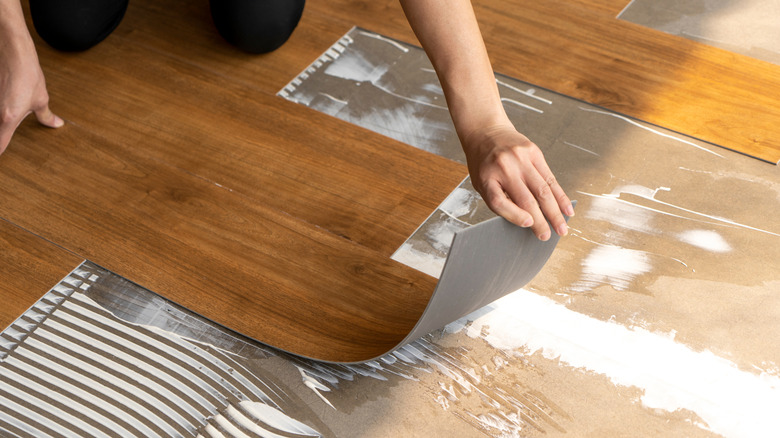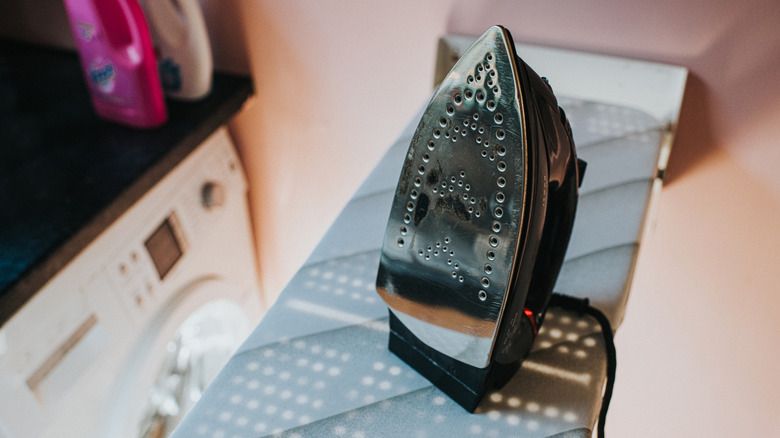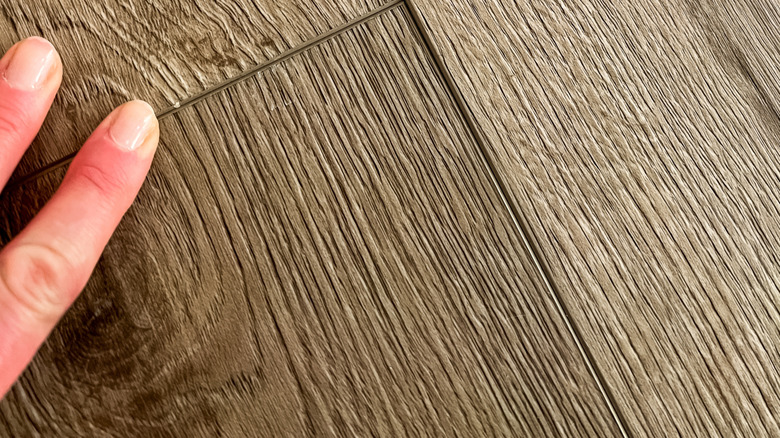Can You Really Repair Vinyl Flooring Using Just An Iron?
We may receive a commission on purchases made from links.
Vinyl is a popular flooring choice because it can mimic hardwood or stone tiles, but is more affordable and a more durable choice for households with children and pets. Vinyl is easy to clean and water-resistant, and, as a result, is often used in bathrooms, laundry rooms, and kitchens. The most common types of vinyl flooring include planks and tiles, which can lift over time. Although you can easily wipe away spills from the surface of vinyl, excessive moisture can seep underneath and weaken the adhesive. Areas of heavy foot traffic can also experience weakening adhesive over time, leading to loose or lifting flooring. This is a tripping hazard, and it should be dealt with immediately.
A popular solution for repairing vinyl flooring is using a clothes iron. Warming glue will reactive the adhesive and make it tacky once again. It will also soften the glue, allowing you to lift the tile and add more adhesive if necessary. It would be a quick, easy, and affordable option for repairing loose vinyl flooring, but does it work? Josh Byrd, owner of Footprints Floors Nashville, told House Digest in an exclusive interview, "I believe it's possible. I mean, the idea makes sense, but doesn't seem like a long term solution. I could see this working for a short duration, and then failing again." Basically, you can use the iron hack in a pinch to remove an immediate hazard while you look into more permanent options, but it shouldn't be relied upon for a full repair.
How to use an iron to repair vinyl flooring without causing damage
Before you tackle the iron hack, there's something important you need to consider. "Make sure you know the installation method of your floor," Byrd said in his exclusive interview with House Digest. There are two types of vinyl flooring installation: glue-down (which is glued directly onto the subfloor beneath) and floating (which "floats" above the floor). "You can only perform this hack with glue-down vinyl, not floating as there is not adhesive to warm up." Unsure which method was used on your floors? There's a hack for identifying floating vs. glued-down floors, which is to pull up a vent and have a peek. If you find your flooring is floating, don't be discouraged. These floors simply click-lock together, which makes it much easier to replace individual planks.
To avoid damaging your vinyl floors, keep the iron on medium heat and place a piece of aluminum foil between the floor and the iron. Byrd warned, however, that you could face some problems if you're not patient. "Potential issues would include burning or discoloring your floor. I would recommend going slow and completing short durations of heat," he said. A safer way to warm up your vinyl is to use a hair dryer on low heat, which is less likely to cause damage. Reactivating the current adhesive may be all that is needed for small lifts, or you may need to gently lift the tile or plank and add additional adhesive such as Henry Vinyl Repair.
How to replace a vinyl tile or plank
According to Byrd, this hack isn't going to guarantee permanent results. "The best and recommended fix is to replace any failing planks or tiles with new. That is why we always recommend keeping some spares around," he said in his exclusive House Digest interview. If you find the iron hack isn't working to keep your vinyl floor in place, you need to swap out the loose tile.
Remove the loose or damaged flooring by loosening the adhesive with the iron method mentioned above, then use a putty knife to carefully pry it out without damaging the surrounding tiles or planks. Before gluing a new piece to the subfloor, make sure it is dry, clean, and level. Moisture, dirt, or an uneven subfloor will deter the adhesive and cause your new flooring to lift soon after installation. If your vinyl flooring has an adhesive backing, simply remove the protective paper and press into place, paying attention to the direction and pattern of the existing floor. If your flooring isn't pre-pasted, apply glue to both the subfloor and vinyl floor and press down firmly (the best glue for vinyl floor tiles depends on the floor type, so do your research). Place a heavy book on top and avoid walking over the floor for 24 hours. If you notice multiple pieces of your vinyl flooring are lifting or loose, there is probably a subfloor problem that needs to be addressed by a professional.


